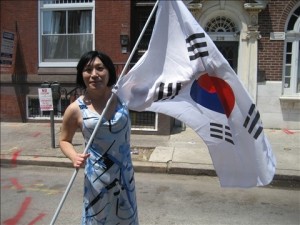
Finding the Authentic Self: Coming Out as a Transgendered Korean Adoptee
By Pauline Park
Being a transgendered Korean adoptee has meant a life-long process of coming to terms with identity issues related to gender identity and sexuality as well as to racial, ethnic and national identity. Just as I have always known that I was an adoptee, I have always known that I was transgendered; but precisely what that meant to me and to the larger world would take me decades to understand and articulate.
While there are obvious differences between the experiences of those lesbian, gay, bisexual and transgendered (LGBT) people who grow up in Korean American families and my adoptive family – my Norwegian American father and my German American mother and grandmother, all devout Lutherans – the patriarchal heteronormativity of Korean and Korean American families finds a striking parallel in that of the German American culture of Milwaukee in the 1960s.
The regular church attendance as well as the piano and violin lessons and practice that are expected of so many Korean American children were dominant elements in my childhood and adolescence as well. And my parents were not merely ‘Sunday Christians’; they were as devout and committed Christian fundamentalists as are to be found in most any Korean American church in Koreantown in Los Angeles or in Flushing or Skokie.
Around the time of my confirmation, the Lutheran Church-Missouri Synod was taken over by its fundamentalist wing, coinciding with a change in minister at our home church. The likeable and theologically moderate pastor I had grown up with and who had confirmed me left us to lead an LCMS congregation in Iowa and was replaced by a fundamentalist minister who preached fire-and-brimstone homophobic sermons from the pulpit just as I was trying to come to terms with same-sex attractions that began with puberty. These developments hastened my exit from the mother church when I moved away to go to college.
I came out as gay in my first semester at the University of Wisconsin-Madison, but I understood even then that my first coming out was incomplete one, as it addressed my sexuality but not my gender identity. I spent my fourth year at the UW in a study abroad program in London and stayed for a second year to do my master’s degree at the London School of Economics. In that second year in London, I began going out regularly in public dressed as a woman for the first time, and it was one of the most liberating experiences of my life. But when I returned to the United States after my two years abroad, I also went into a period of denial about my gender identity. However, my mother did come to accept my sexuality just before her death only a few months after my return from London, though she never knew about my transgender identity. (My father died just before I turned 13, and so he and I never had the opportunity to discuss – or argue about – sexuality and gender issues.)
After a career in public relations and another one in academia, I came out as an openly transgendered woman when I moved to Queens in 1997. And while my first coming out was a huge step for me, my second coming out was bigger still in its implications for my life and work. It is not an exaggeration to say that I came out as transgendered through my activism and advocacy work, co-founding a number of organizations, including Queens Pride House (a center for the LGBT communities of Queens) and Iban/Queer Koreans of New York (Iban/QKNY) in 1997 and the New York Association for Gender Rights Advocacy (NYAGRA) in 1998.
I also came to see a parallel between my identity as a transgendered woman and my identity as a Korean adoptee: just as I came to realize that the sex/gender binary constructed an artificial and ultimately false dichotomy between ‘man’ and ‘woman’ (heteronormatively defined), I came to understand that I had a set of experiences and a life history as a Korean adoptee that was distinct from that of Koreans or Korean Americans just as it was different from European Americans, despite my having grown up in a white household and in an all-white neighborhood on the south side of Milwaukee. What had impeded the resolution of both identity complexes had been a false discourse of authenticity; the authentic identity was to be found only through an articulation of the true self and its ultimate expression through advocacy on behalf of those communities of which I was a member.
It was on 29 February 2000 that I found myself suddenly transformed into a public figure as we launched the campaign for the transgender rights law ultimately enacted by the New York City Council in April 2002. Leading that legislative campaign was the honor of a lifetime, and since its successful culmination, I have found countless opportunities to speak out on behalf of queer Koreans and other Asians and Pacific Islanders (APIs) and the LGBT community at the local, state, and national levels. As the Mahatma Gandhi so rightly put it, “The best way to find yourself is to lose yourself in the service of others.” And so I have.
This essay was published in June 2010 in “Resist & Exist,” a ‘zine edited by Sam Jung & Sarah Shim.